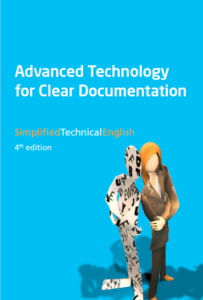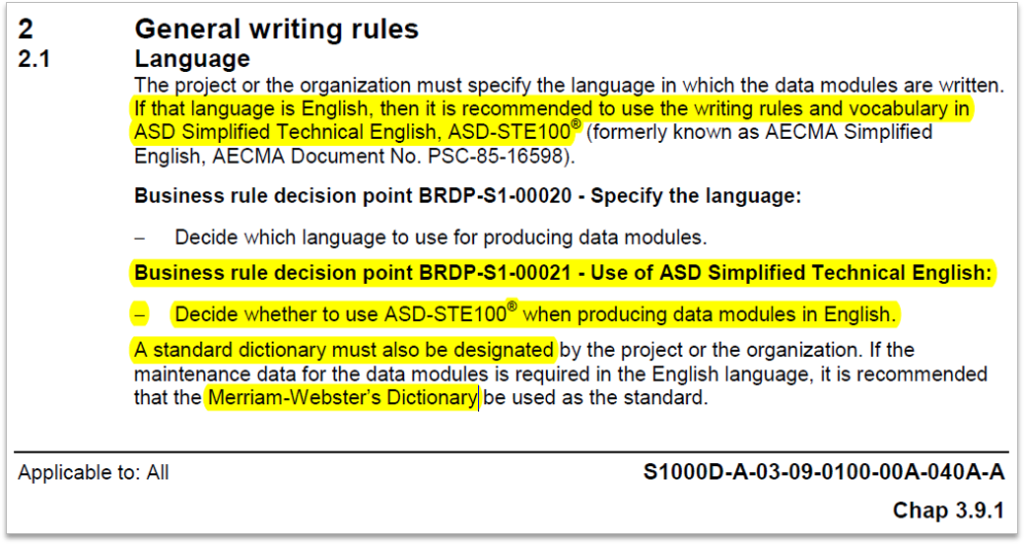Clarity in writing for the aerospace and defense industry
ASD-STE100 Simplified Technical English (STE) has promoted clarity in writing since the mid-80s and more companies are adopting it now than ever before. So, let’s have an in-depth look at STE, the value it brings, and how to set your metrics and KPIs.

What is STE?
STE is a controlled language developed in 1986 so that second-language speakers of English could clearly understand technical information written in English. The specification can be requested for free and gives technical authors approximately 60 writing rules and a dictionary that contains about 3,000 words (although companies will need to add their own terms as well). When writers use the rules and the approved words, they are more likely to create information that is clear and concise. Companies outside the aerospace and defense industry are realizing the benefits of writing in STE. Currently, more than 60% of companies requesting a free copy of the STE specification are not aerospace and defense companies. For an historic overview and more in-depth information, please request our free 112-page booklet: Advanced Technology for Clear Documentation [Refer to Figure 1].
Is STE a requirement for the aerospace and defense industry?
Having implemented STE for close to 20 years and trained over 3000 technical writers worldwide, we always ask our customers why they want to become STE compliant. The most common answer we hear is that STE is required by the contract. For instance, contracts for aerospace or military platforms frequently state that technical publications will have to comply with specifications like S1000D or ATA iSpec 2200. S1000D, for example, states that if the documents are in English, then ideally the documents be STE compliant. [Refer to fig 2.] This is a legitimate reason to use STE because any company that does not comply could lose business because it:
- cannot deliver the required standard of technical publications;
- loses out to competitors who can supply technical publications in STE;
- does not qualify for tender opportunities; and
- may even lose supplier status.

Consequently, with STE-compliant data you can:
- optimize the delivery of technical documentation;
- maintain compliance as a supplier;
- access new industries; and
- be first to market.
What values does STE bring?
So, the contract requires that you use STE. However, the question that you really need to ask yourself is WHY was the requirement for STE put in the contract in the first place? What are the business drivers for using STE for technical publications? What values does STE bring and are there case studies from companies with meaningful metrics?
Safety!
Technical information plays a crucial role in safe product use and maintenance. We cannot assume that information that is clear to us is therefore also clear to our end users. Technical writers can have different language, cultural and technical backgrounds, and write for an audience that may or may not have English as their native language and may also have different cultural or technical backgrounds. English is a rich language with many words having more than one meaning, so it’s easy to get confused. Confusion and misinterpretations can lead to dangerous situations.
One (quality) voice
STE helps you to create one voice for your customers because it gives all of your writers, wherever they are in the world, a common standard to work to. One example is the use of consistent terminology throughout your technical publications. STE also improves the quality of your writing because it enforces clarity. If end users can easily understand the supporting documentation, they are more likely to be satisfied with their product, which will positively affect your company’s reputation and brand.
Cost savings
STE can also create efficiency throughout the product lifecycle, including:
- shorter time-to-market as STE leads to a more efficient writing and editorial process (writing less content that is more reusable, and faster and cheaper to translate) in the long run;
- efficient installation, commissioning and training thanks to the short and clear instructions;
- safe and efficient operations, increased productivity, and uptime; and
- improved aftermarket business thanks to the consistent use of terminology in (spare) parts, making them easier to find and buy.
Future proof
In addition to making content more reusable due to it being short and to-the-point, especially when combined with specifications like S1000D, STE also facilitates your digitalization, IoT (Internet of Things) and Augmented Reality strategies.
Digitalization is an important industry trend, where companies are digitizing their products and product information to create more value for their customers. STE facilitates this because it allows for digital data, which is now clearer and more concise, to be used, for example, for:
- machine learning (an important aspect of IoT) to make products more intelligent, and;
- augmented reality applications, such as providing field service engineering with interactive and clear instructions on headsets.
Remember, your end user doesn’t care about which standards you use to create, manage and publish your content. An end user, like a field service engineer, is only interested in getting quick and easy access to information that will allow him/her to do their job efficiently. Again, this can have a positive effect on your branding.
Setting metrics and KPIs
As the saying goes: ‘you don’t know where you’re going if you don’t know where you’ve been’. In other words, in order to set your goals, such as quality score and cost savings, you first need to know what your current cost or inefficiency is, which is not always easy to do. For instance, if you are looking to save translation cost, find out what you are currently spending. The metrics we provided earlier are good indicators of where you can save on cost and efficiency, and where you can improve on quality. You can use the reports generated by checker software to create a baseline measurement on where your content is today as far as complying with STE and other writing rules. This will then help you define your goals for the future as you continue to measure and adapt these as you move forward.
Over the years we have been able to achieve some great results for our customers. These are some good indicators of what can be achieved:
- Up to 30% in cost savings on translation and localization. Due to an increase in consistent use of words and short sentences, translation costs will go down.
- Up to 40% in reduced word count, mainly as a result from learning how to write the ‘need-to-know’ and omit the ‘nice-to-know’, which is a direct result of receiving STE writer training.
- Quality improvement in writing and translations. STE will improve the quality of writing as it makes technical text easier to understand. The same is also true for translations as they consequently also become clearer.
- Up to 30% in reduced product cycle time. This is a long-term goal that will be realized as writers will produce less text and therefore will require less time to write content.
- Up to 40% reduction in overall documentation cost. This is another long-term goal that will be realized as a result of these combined benefits.
- Efficient conversion of legacy documents. If you must convert existing (legacy) documentation to STE, having checker software in place can be a great aid as it points out the areas for improvement. Thanks to reports and profile management converting standard text to STE compliant text will become easier.
For more information on what’s involved with an implementation, please visit this page.
We offer free business case analyses if you want to know what STE can do for you. Contact us today for more information!
This article was written by Berry Braster, Technology Director at Etteplan, with a special thanks to Ciaran Dodd, Independent Controlled Language Expert and Trainer, Ciaran Dodd Training for her comments and review.

